Many years ago, near the beginning of his long and successful career as a painter on Martha’s Vineyard, Kib Bramhall wrote down a quotation from the Renaissance painter Albrecht Dürer, which he still keeps at hand in his desk. Inscribed on a random piece of cardboard like an unexpected message, it reads simply: “Art exists in nature and if you can extract it, you have it.” To a younger Bramhall, these were words of discovery and challenge. Now recently turned ninety years old, he finds they still speak to his source of inspiration and his love of the nature of this Island, his subject for a lifetime of art.
Bramhall describes his subject as “life at the rim of the sea.” It is a vast vision, full of the quiet drama in nature that has moved him to paint for more than sixty years: fish and their waters, beaches and their windswept vegetation, storm clouds and sunsets, a solitary house under a thick blanket of snow, a bird on the wing, a single blade of beach grass bent in the wind. A realist painter, Bramhall says he paints “what I see,” which means that his eyes alone are the connection to the beauty he observes in nature, without any attempt at decoration or idealization. It is a spontaneous and also demanding way of portraying nature that speaks to his many deep and affecting experiences in its midst.
Before Bramhall was a passionate painter, he was a passionate fisherman, and the sea was where he first encountered the power and the mystery of his subject. Remembering the moment he caught his first fish, a small but “incredibly beautiful” striped bass at age seven, he wrote in his fishing memoir, Bright Waters, Shining Tides: Reflections on a Lifetime of Fishing (Vineyard Stories, 2011), “I can still feel the awe and excitement, and yes, the fright of that take.” Adding to that thought he concluded, “My spirit and the water and the fish were bonded forever in that moment.”
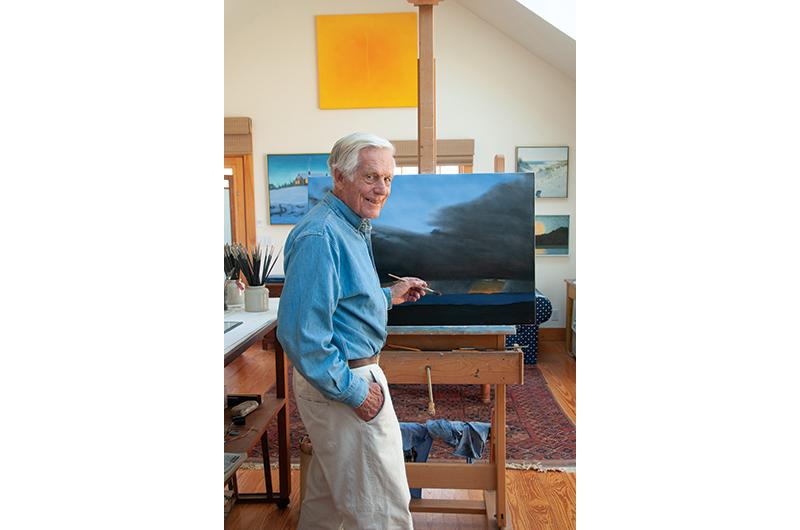
In his career, Bramhall would paint many solo portraits of striped bass, one of his favorite fish to catch, along with false albacore, bonito, and bonefish. Perhaps the most moving, in its simplicity and reality, is an image of a handsome striper swimming in water so clear that it reflects the shadow the fish casts on the sand below, like a verification of its very presence. In its careful detail and the glint of admiration, it also tells of the intimate relationship that exists between artist and subject.
Equally personal and reflective of his life are Bramhall’s many portraits of the sea, which, as a fisherman, he had come to know in its many moods: tranquil and inviting, boisterous and intimidating, an ever-changing display of tides and waves and currents that are only rarely still. His classic view of the sea is a distant and admiring one that depicts an endless expanse of rippling blue or emerald-green water, framed by its near shore, and often encompassing a glimpse of sparse wildlife, a skitter of sanderlings, a clump of beach grass.
Many of Bramhall’s earlier paintings spoke simply of the adventures to be found in the sea. A lively portrait called Wasque, which was Bramhall’s first sale at the Old Sculpin Gallery in Edgartown in 1957, shows his father and brother side by side near the shore casting into breaking waters and suggests an impending catch by the bend of one of the rods. Painted a year later, Night Fishing, an oil sketch on canvas paper, depicts his preferred mode of fishing in those days, and bathes it in what he calls “pervading dark,” which is the time fish like to come inshore to feed in the shallows. The work is an evocative composition of light, dark, and darkest blues and blacks that obscure the sky and water and leave almost unnoticeable a lone shadowy figure standing on the shore and casting. The painting is searching and soulful and elicits feelings of awe and loneliness and wonder all at once. Mostly it seems provocative, striking a note of the modern along with a hint of the romantic. Like much of his work, it also seems to tell a story, yet leaves it unspoken, a matter that belongs in nature.
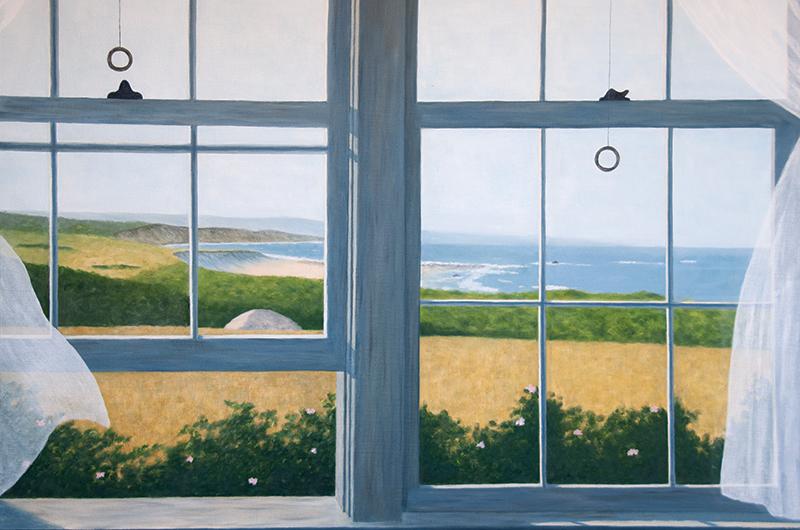
Art first entered Bramhall’s life at seventeen when, as a junior at the Hotchkiss School in Connecticut, he rather blithely chose to take a course in art over one in music. The decision “turned my life around,” as he put it, and led to his first work of art that same year, a dark and dramatic seascape of a boat and two young fishermen trying to navigate stormy waters. A decade later – having graduated from Princeton University with a B.A. in art and archaeology, served in the Army, and settled near Boston with his wife, Tess, and the first of their three children – he was working at Salt Water Sportsman, a fishing magazine where he was its all-purpose advertising director and writer, covering the fishing scene in New England and beyond.
Bramhall’s eighteen years at the magazine seem serendipitous now, for they immersed him in a world that he had found seductive as a summer kid on Martha’s Vineyard, fishing the famed rip at Wasque Point. With the magazine, he traveled to nearby and far-flung fishing waters, hung out with talented anglers, and caught big fish, his head filling with the great mystery of the sea and his zeal to make a connection. He was painting in the evenings then, had sold a few works to a local gallery, and was going to his easel with ever-greater enthusiasm. His life in art was coming together, he said, and in 1973 he retired from the magazine to devote himself full-time to painting. In 1980, after their youngest child graduated from high school, he and Tess moved year-round to the Island, selling their long-time summer home in Edgartown and moving to a house they built in the woods on Seven Gates Farm in West Tisbury, in the company of ancient oaks and a distant vista of Vineyard Sound.
On his easel there late last fall was a work in progress that focused on the field of bright orange butterfly weed that had popped up outside his studio window, its happy new presence an interesting contrast to the stoic face of an aged stone wall in the picture. For many years, Bramhall has been using a camera to capture the scenes in nature that he once sketched en plein air. (A bird colliding with his easel was responsible for his change of course.) “I will be struck by something I see and I have to record it on camera or in a sketchbook to keep it in mind. Then I decide the size and shape of the canvas – very important to me, I don’t know why – and then do the minimal amount of sketching as I am anxious to get to the colors,” he said. “I like to get the whole canvas covered as quickly as possible.” He smiled, adding that he is compulsively hardworking, “perhaps like a sportsman.”
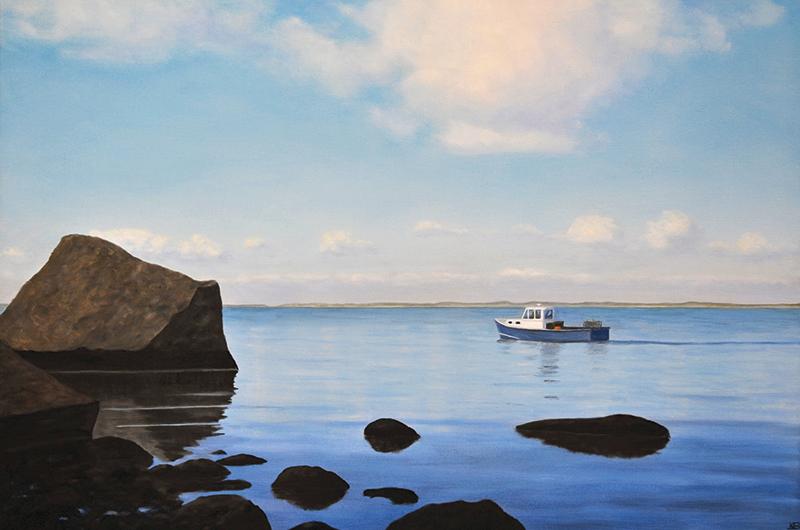
Chris Morse, who with his wife, Sheila, owns the Granary, Field, and North Water Galleries on the Island, has followed Bramhall since the 1980s and speaks of his seriousness and “the powerful quiet of his painting.”
“Kib is editing out specifics and giving integrity to a piece, like he was whittling out the noise,” Morse said. Bramhall’s own words describe his art simply: “I try to make my portraits timeless – no beer cans on the beach – nothing but the true essence of the beauty that the artist has seen, nothing that is mutable and everyday.”
In the late 1970s and early ’80s, as Bramhall settled into full-time painting and permanent residence on the Vineyard, there was a new clarity in his work and his ambitions intensified. Not that he put aside his fishing; he was still a master angler with a succession of aluminum “tin” boats, an old canoe, and, eventually, an eighteen-foot Boston Whaler. In a few years he would land the first of several record flyrod catches with a 42.14-pound striped bass. (He still holds the world record for Atlantic bonito caught on eight-pound tippet.) But, as he said of his new life: “Fishing and painting are separate subjects except when I am painting fish.”
The 1980s and ’90s was something of a golden age for him as a painter. At the beginning of the ’80s, he had begun to show his work at the estimable Coe Kerr Gallery on New York’s Upper East Side, where the Wyeth family was also represented. Over the next ten years, Bramhall was given three one-man shows at the gallery, which sold well, confirming his reputation as a significant landscape painter. It was an exhilarating and energizing time for the artist, who was completing some forty paintings a year. But when the gallery closed its doors in 1994, Bramhall didn’t feel the need or desire to seek further representation off-Island. His reputation by then was such that he had no trouble selling his work through occasional shows at the Granary Gallery in West Tisbury and the now-closed Craven Granary in Vineyard Haven.
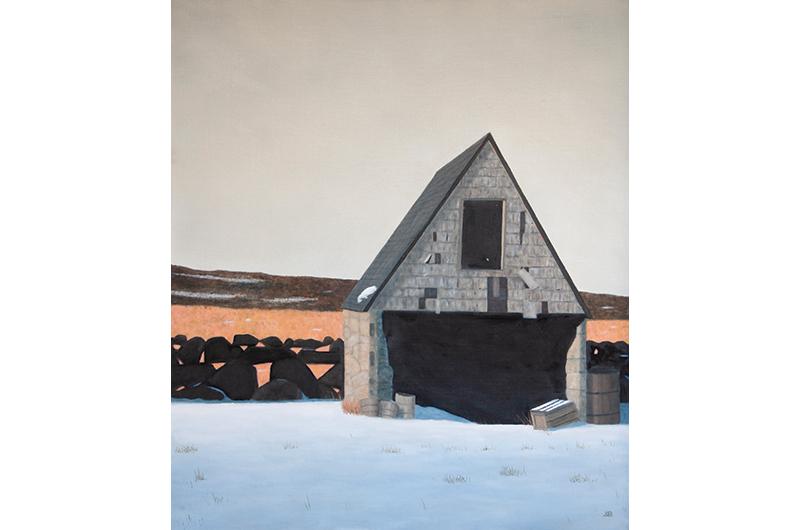
After the high velocity of New York, Bramhall returned happily to the pace of Island life and his classic portrayals of the sea and nature: paintings that speak softly to the astonishing beauty of the Island: a beach in the receding waters of low tide; the transformative power of snow on a familiar landscape; the message to be found in a sky of billowing clouds. He was painting widely in nature, inspired by his deep capacity to observe: a snowy owl staring out from a perch on a piece of beach fence; a sunspot flashing on the sea; a winding path through autumnal trees that are wearing an extraordinary and dominating shade of ochre. “I am what I paint,” he has commented about his range of work, which invites reflection and contemplation, and in quiet tones intimates discovery and wonder. He is painting the same world he was painting thirty-five years ago, he said with one of his ready smiles.
However serious and consistent a painter he may be, he can be surprising too, as if to challenge his viewer or himself with a shift of subject, or merely to indulge himself with a note of humor or an unexpected piece of nature. He has painted a portrait of a single very large and very black rock like a piece of architecture, a massive steer wading in shallow waters, and a pair of grapefruit that look as happy as lovers, and he seemed to be reminding himself of the fun in life with his series of giant-sized and glowing fried eggs. His still life that pictures a collection of fishing lures, which he painted in the 1980s, seems to express something personal, like a loving memory.
Among the many treasured mementos and images that fill the walls of Bramhall’s lofty studio at Seven Gates is a photograph of the celebrated Island painter Stan Murphy sitting in his studio. Many years ago, Murphy, known as the dean of Island painters until his death in 2003 at the age of eighty-one, took pleasure in his support and mentorship of younger painters, among them his friend Bramhall. As his own career has blossomed, Bramhall too has also followed the work of younger artists on the Vineyard, Max Decker and Colin Ruel among them, whose work he admires and has encouraged. Sketches by both artists are displayed not far from the photograph of Murphy.
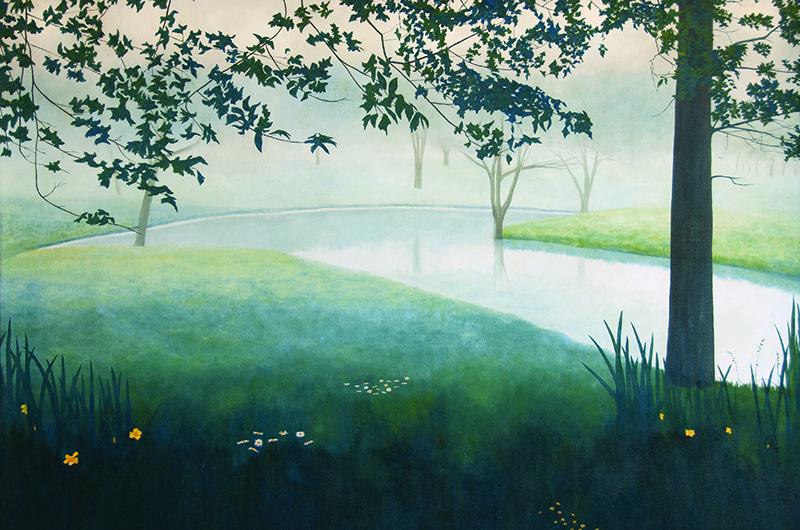
“He is a hero for sure,” Ruel said eagerly of Bramhall, mentioning their long talks about art by phone or in Ruel’s Menemsha gallery. Decker recalled that, as a kid growing up on the Island, it was Bramhall that inspired him to become a painter. In the vast display on the studio wall, in its way recording time, there is a small painting of winter by Bramhall’s art teacher at Hotchkiss. There is also his first painting at Hotchkiss, his first painting of Tess, and his only self-portrait, sketched in pencil in 1977.
As Bramhall enters the noble age of ninety, a milestone he celebrated in June, his work seems as constant and ageless as the subject of nature, which never ceases to sustain his vision. Still, he has changed the way he shares it with the world. Since 2017, when he began to post examples of his work on Instagram (@kib_bramhall) every week, he has gained a worldwide following of fans who often comment on his work, which can be enlightening as well as encouraging. In a meaningful way, Instagram has also provided a way for friends, children, and grandchildren to see all of his work, and for Bramhall himself to review his own life story in paintings.
Bramhall still paints most days, and at times he paints immediately after sighting something that strikes him as a precious moment, revealing something true in the drama of nature. One evening last spring, as he watched from a window, he saw a dark and ominous bank of thunderheads moving across the sea, almost occluding a sky that was still fiery with the last rays of sunset. Several weeks later, he had sketched, painted, and posted online the painting he called Thunderstorm, which is a dramatic and enveloping portrait of nature happening. It brings to mind a line from a statement Bramhall wrote to himself back in the early ’80s. “I find nature endlessly beautiful and mysterious, and I want to record as accurately as possible those times when she makes me catch my breath.”

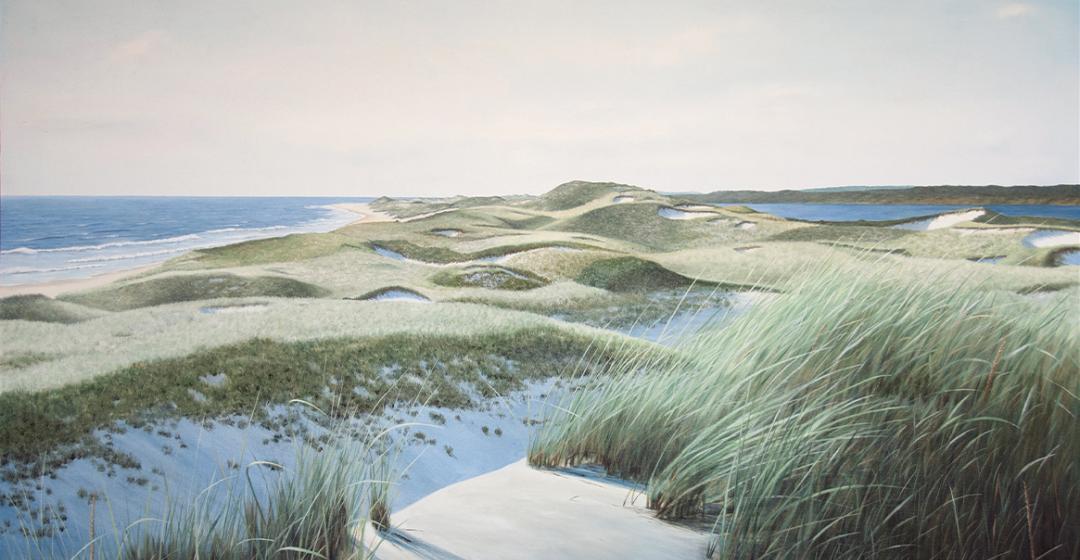


 2 comments
2 comments
Comments (2)